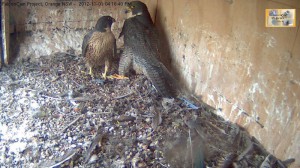At fledging, females should be 80% wingsize of adults, and males about 83%. On that basis, one would assume Snow is a male. He is considerably smaller than Swift – see attached.

However, it is known that males mature more quickly and often leave the nest earlier than females, so am not 100 % sure. At mature nestling stage, such as this, there is something called ‘reverse dimorphism’ whereby the male can be actually larger than the female.
If there is anyone out there who would like to stick their neck out and make a pronouncement, let us know!
Cilla
Greetings from Buffalo, New York, USA. This was my 1st time watching this site. When Snow was covered with fluffly down, I assumed she was female because she looked so big. Now, with juvenile plumage, Snow looks more like a male. After watching various peregrine nestboxes, I have never seen such a serene & cuddly (esp with Mum Swift) raptor! Hard to believe he/or she will soon be swooping down on prey. I never was able to get audio with this site, but I will dearly miss Snow’s daily antics.
I should correct my post to read “female fledglings should be 80% wingsize of adult FEMALES, and male fledglings about 83% of adult MALES”.
Apologies. That makes it a bit clearer. Adult emales are considerably larger than adult males, as with all birds of prey.
Perhaps another photo showing Snow side-by-side with Beau would be helpful 🙂